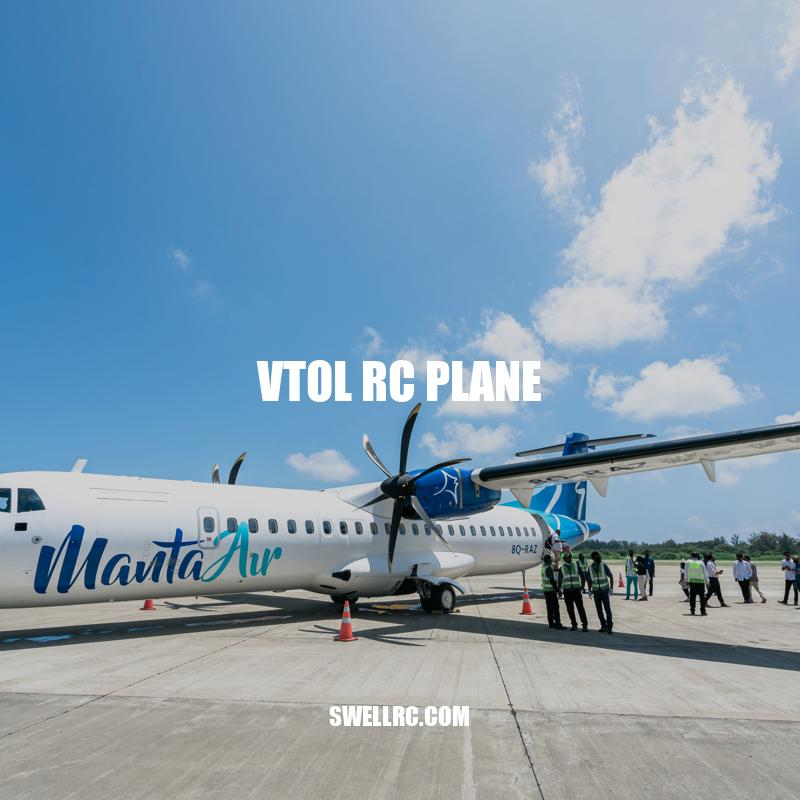VTOL RC Planes: The Pros and Cons of Flying a Vertical Takeoff and Landing Remote Control Aircraft
Vertical Take-Off and Landing (VTOL) RC planes are an exciting advancement in the world of remote-controlled aircraft. These small, yet powerful planes are capable of taking off and landing in small spaces and hovering in mid-air like a helicopter. The unique design of VTOL aircraft means that they are highly maneuverable and allow for complicated aerial stunts that traditional RC planes can’t pull off. Additionally, VTOL planes are much more versatile than traditional models that require a large runway or grassy field to take off and land. As a result, these planes are great for indoor flights and can be flown in tight spaces, even in a small backyard. With the recent advancements in technology and an increasing beginner-friendly market for VTOL RC planes, they have become more accessible to everyone who wishes to give it a try. In this article, we will discuss everything you need to know about VTOL RC planes, including their advantages, disadvantages, and tips for flying.
Types of VTOL RC Planes
There are two main types of VTOL RC planes: fixed-wing designs with tilting rotors and quadcopter-style designs. Here are the pros and cons of each:
- Fixed-wing designs with tilting rotors: These planes have a traditional plane-like design but with rotors that can tilt upward for vertical takeoff and landing.
- Pros:
- Faster and more efficient in forward flight
- Better suited for outdoor use
- More stable in windy conditions
- Cons:
- Require more skill to fly
- Less maneuverable than quadcopters
- Quadcopter-style designs: These planes have four rotors that provide lift for takeoff and landing, and they can hover in mid-air like a helicopter.
- Pros:
- Easier to fly and control
- Highly maneuverable
- Great for indoor flights and tight spaces
- Cons:
- Slower and less efficient in forward flight
- Less stable in windy conditions
Overall, the type of VTOL RC plane that’s best for you will depend on your skill level, intended use, and personal preferences. Before making a purchase, be sure to do your research and read reviews from other RC enthusiasts. Websites such as Amazon and Horizon Hobbies offer a wide range of VTOL RC planes that you can choose from, and some of these products come with features such as built-in GPS and advanced stabilization systems.
How many types of RC planes are there?
There are various types of RC planes available, including scale model aircraft of fixed-wing gliders, single or multi-engine planes, autogyros, and helicopters. RC planes are operated using radio control systems that transmit signals remotely to control the device. For more information, you can visit websites such as RCRC or browse through products related to RC planes.
The Benefits of Flying a VTOL RC Plane
Flying a VTOL RC plane comes with several benefits that make them a popular choice for RC hobbyists. Here are a few:
- Ability to take off and land in small spaces: With their vertical takeoff and landing capabilities, VTOL RC planes can take off and land in areas that traditional RC planes can’t, making them perfect for flying in small parks or even indoors.
- Flexibility in maneuverability: VTOL RC planes can hover in mid-air like a helicopter and fly like a traditional plane, giving them more flexibility in maneuvering around obstacles and performing aerial tricks.
- Multirotor design: The multirotor design used in quadcopter-style VTOL planes provides higher stability and control in mid-air, even in windy conditions.
- Increased safety: With proper use, VTOL RC planes can be flown safely in tighter spaces or areas with more obstacles, reducing the possibility of damage to the plane or harm to people nearby.
- Great for aerial photography and video: The hovering capabilities of quadcopter-style VTOL planes make them ideal for capturing stunning aerial footage and photography.
VTOL RC planes are also known for their innovative designs. Some models feature foldable arms for easier transportation and storage, while others come equipped with high-definition cameras and live video feeds to enhance the flying experience. If you’re interested in getting started with a VTOL RC plane, some websites such as Banggood offer a wide variety of options at affordable prices.
Below is a table comparing the benefits of fixed-wing and quadcopter-style VTOL RC planes:
| Fixed-wing designs with tilting rotors | Quadcopter-style designs | |
|---|---|---|
| Pros | More efficient in forward flight | Easier to fly and control |
| Cons | Less maneuverable than quadcopters | Less stable in windy conditions |
What are the advantages of VTOL drones?
VTOL (Vertical Takeoff and Landing) drones have several advantages. Firstly, they do not require a long runway, making them safer to operate as there is less risk of accidents during takeoff and landing. Additionally, VTOL drones are more reliable than traditional drones as they are designed to maintain stable flight in challenging environments such as strong winds or uneven terrain.
Flying a VTOL RC Plane
Flying a VTOL RC plane comes with its own set of challenges. Here are a few:
- Learning curve: Unlike traditional RC planes, piloting a VTOL RC plane requires a steeper learning curve due to their increased technical complexity and unique capabilities.
- Technical complexity: With their multirotor design and tilting rotors, VTOL RC planes require more technical knowledge and setup than their fixed-wing counterparts.
- Battery life: VTOL RC planes require more battery power due to their complex design, so pilots need to carefully manage their flight time to avoid running out of power mid-flight.
- Cost: The increased technical complexity and unique design of VTOL RC planes can make them more expensive than traditional RC planes.
- Safety: Due to their increased flexibility and maneuverability, VTOL RC planes can pose more of a safety risk if not flown responsibly and in a controlled environment.
Despite the challenges, flying a VTOL RC plane can be a rewarding experience for those willing to put in the time and effort to master piloting it. To make the learning process easier, there are plenty of online resources available, including forums where pilots can ask questions and share tips, as well as tutorial videos on platforms like YouTube. Some retailers, such as Hobby King and Tower Hobbies, also offer VTOL RC planes specifically designed for beginners, which can help ease the learning curve and make the hobby more accessible.
It’s important to keep in mind that safety should always be a top priority when flying any type of RC plane. Always follow local regulations and guidelines, and only fly in designated areas away from people, buildings, and other obstacles.
What are the benefits of VTOL?
VTOL (Vertical Takeoff and Landing) drones provide increased flexibility as they can take off and land vertically, which makes them suitable for use in areas where horizontal runway is not available or limited. Moreover, these drones reduce the risk of accidents during takeoff and landing, making them safer to operate.
Tips for Flying a VTOL RC Plane
If you’re interested in learning to fly a VTOL RC plane, here are some tips to get you started:
- Start small: Begin with a smaller, more entry-level VTOL RC plane to get the hang of piloting this unique type of aircraft.
- Practice: Like any new skill, practice makes perfect. Set aside dedicated time to fly your VTOL RC plane and work on your piloting skills.
- Use simulators: There are RC flight simulators available that can help you practice flying a VTOL RC plane in a simulated environment, which can be a helpful training tool.
- Join a community: Join an online forum or Facebook group dedicated to VTOL RC planes where you can ask questions, get advice, and interact with other pilots.
- Invest in quality equipment: Investing in quality equipment, such as a good transmitter and receiver, can help you fly more reliably and with greater precision.
- Learn the terminology: Becoming familiar with the terminology used in the RC world can help you better understand how your VTOL RC plane functions and how to troubleshoot any issues that may arise.
As with any new hobby, it’s important to be patient with yourself and take the time to learn the basics before moving on to more advanced techniques. Websites like Flite Test and DroneDeploy offer valuable resources for VTOL RC pilots, including tutorial videos, forums, and product reviews. By following these tips and resources, you’ll be on your way to mastering the exciting world of VTOL RC planes.
How do you learn to fly RC planes?
One way to learn how to fly RC planes is to watch tutorial videos on YouTube, such as the video titled “How to Fly RC Planes” by FliteTest. It is also recommended to start with a beginner-friendly plane and find a local RC flying club for support and guidance.
Advancements in VTOL RC Technology
As VTOL RC planes continue to grow in popularity, manufacturers are constantly looking for ways to improve their designs and incorporate new technology. Here are some of the latest advancements in VTOL RC technology that are changing the game:
- Built-in GPS: Some VTOL RC planes now come equipped with GPS, which allows for more accurate navigation and the ability to “return to home” if the plane drifts too far away or loses connection.
- Advanced stabilization systems: Newer VTOL RC planes often feature advanced stabilization systems that make it easier to fly and keep the plane level, even in windy conditions.
- Improved battery technology: Lithium polymer (LiPo) batteries have become more popular in recent years, offering longer flight times and faster charging capabilities.
- Ultra-compact designs: Some manufacturers are experimenting with ultra-compact VTOL RC planes that can fit in the palm of your hand, making them highly portable and easy to fly in tight spaces.
- High-definition cameras: Many VTOL RC planes come equipped with high-definition cameras that provide stunning aerial footage and images, opening up new possibilities for photographers and videographers.
- Autonomous flight: Some higher-end VTOL RC planes now offer features such as automatic takeoff and landing, as well as autonomous flight modes that allow the plane to follow a predetermined path or track an object.
Websites like GetFPV and HobbyKing offer a wide range of VTOL RC planes and accessories, as well as product reviews and forums where pilots can discuss the latest advancements in technology. By staying up-to-date on the latest trends and innovations, you can take your VTOL RC flying to the next level.
What are the different methods of VTOL?
Currently, there are two types of VTOL technology: rotary wing aircraft and powered-lift. Rotary wing aircraft use rotor blades to spin around a central mast to create lift. For more information about the different types of VTOL technology, websites like Vertical Flight Society and Aerospace Technology are great resources.
Conclusion
VTOL RC planes represent an exciting and growing segment of the RC community, offering unique capabilities and thrilling new experiences for pilots of all skill levels. While they may require some additional learning and technical know-how compared to traditional RC planes, the rewards are well worth the effort.
By practicing on beginner models, learning from online resources and community forums, and staying up-to-date on the latest advancements in technology, pilots can take full advantage of everything that VTOL RC planes have to offer.
Whether you’re looking to explore new aerial photography opportunities, test your piloting skills, or simply try something new and exciting, VTOL RC planes are a fantastic option. With their versatility, maneuverability, and ever-improving technology, the sky is truly the limit.



